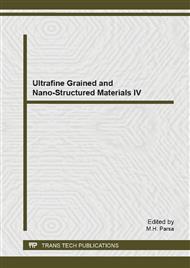p.554
p.559
p.563
p.568
p.572
p.577
p.583
p.589
p.594
Production of Cu-TiC Nanocomposite Using Mechanical Alloying Route
Abstract:
In this study, Cu-TiC nanocomposites were produced by high energy ball milling of elemental powders and in-situ formation of TiC in the copper matrix. Cu-40wt% Ti powder mixture were milled for 60 h, then graphite powder was added, subsequently milling was continued for further 10 h. Based on theoretical calculations, at this composite, the amount of TiC as reinforcement should be 60.25vol% (45.47wt%). The effect of milling time on solution progress of titanium in the copper lattice was studied by X-Ray diffraction analysis (XRD) with CuKα radiation. Considering XRD of Cu-40wt%TiC after 60 h milling data and Williamson-Hall relation, crystallite size and lattice strain of copper were determined 12nm and 1.04% respectively. To ensure the formation of titanium carbide, XRD analysis was performed after pressing at 300MPa and sintering at 900oC for an hour and heating rate of 2.5oC/min. XRD pattern was indicated the formation of TiC,CuTi3 and TiO2 phases in Cu matrix.
Info:
Periodical:
Pages:
572-576
Citation:
Online since:
November 2013
Authors:
Keywords:
Price:
Сopyright:
© 2014 Trans Tech Publications Ltd. All Rights Reserved
Share:
Citation:


